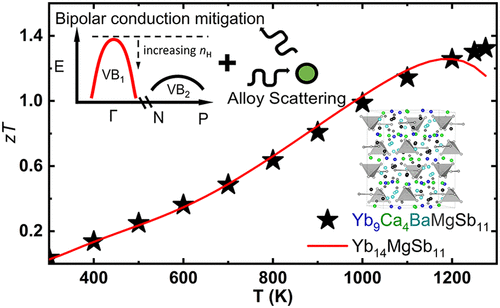当前位置:
X-MOL 学术
›
Chem. Mater.
›
论文详情
Our official English website, www.x-mol.net, welcomes your
feedback! (Note: you will need to create a separate account there.)
Evolution of Thermoelectric Properties in the Triple Cation Zintl Phase: Yb13–xCaxBaMgSb11 (x = 1–6)
Chemistry of Materials ( IF 7.2 ) Pub Date : 2021-10-11 , DOI: 10.1021/acs.chemmater.1c02584 Christopher J. Perez 1 , Giacomo Cerretti 2 , Elizabeth L. K. Wille 1 , Kasey P. Devlin 1 , Navtej S. Grewal 1 , Andrew P. Justl 1 , Maxwell Wood 2 , Sabah K. Bux 2 , Susan M. Kauzlarich 1
Chemistry of Materials ( IF 7.2 ) Pub Date : 2021-10-11 , DOI: 10.1021/acs.chemmater.1c02584 Christopher J. Perez 1 , Giacomo Cerretti 2 , Elizabeth L. K. Wille 1 , Kasey P. Devlin 1 , Navtej S. Grewal 1 , Andrew P. Justl 1 , Maxwell Wood 2 , Sabah K. Bux 2 , Susan M. Kauzlarich 1
Affiliation

|
The band structure of Yb14MgSb11 is tuned by substituting the more earth-abundant cations, Ca and Ba, on the four crystallographically distinct Yb sites (Yb13–xCaxBaMgSb11 (x = 1, 2, 3, 4, 5, 6)). Single crystals of composition Yb9.7(2)Ca3.85(5)Ba0.29(4)Mg1.13(3)Sb11.0(1) were grown from Sn flux revealing the cation site preferences. Magnetic measurements on this crystal show paramagnetic behavior consistent with the presence of ∼0.85 Yb3+. High-purity samples (>98%) with compositions close to nominal of Yb13–xCaxBaMgSb11 (x = 1–6) were prepared by ball milling and spark plasma sintering. The carrier concentration can be rationalized with the presence of Yb3+ for all samples and decreases as a function of x in a systematic fashion at room temperature and increases above ∼600 K for x = 3–6. The temperature dependence of the carrier concentration can be understood considering the electronic structure with a light and heavy band valence band contributing to the properties and suggests the involvement of a localized flat band or impurity state that is active with increasing amounts of Ca. The effect of temperature leads to sustained high Seebeck coefficients with low electrical resistivity arising from the transitioning of the light to heavy band with localization of carriers in the flat band or impurity state for Ca-rich compositions. Speed of sound measurements show that the lattice stiffens with increasing x. Despite the stiffening lattice, the thermal conductivity decreases until x = 3, 4 at which point it increases slightly. The x = 4 sample reaches a peak figure of merit (zT) of 1.32 at 1273 K while being 16% lighter by the molar mass compared to Yb14MnSb11 thereby providing a more power dense material.
中文翻译:

三重阳离子 Zintl 相中热电性能的演变:Yb13–xCaxBaMgSb11 (x = 1–6)
Yb 14 MgSb 11的能带结构通过在四个晶体学上不同的 Yb 位点 (Yb 13– x Ca x BaMgSb 11 ( x = 1, 2, 3, 4, 5, 6))。组成 Yb 9.7(2) Ca 3.85(5) Ba 0.29(4) Mg 1.13(3) Sb 11.0(1) 的单晶是从 Sn 通量中生长出来的,揭示了阳离子位点偏好。对该晶体的磁测量显示顺磁行为与~0.85 Yb 3+的存在一致。成分接近标称 Yb 的高纯度样品 (>98%)13– x Ca x BaMgSb 11 ( x = 1–6) 是通过球磨和放电等离子烧结制备的。对于所有样品,载流子浓度可以通过 Yb 3+的存在来合理化,并且在室温下以系统的方式作为x的函数降低,并且对于x增加到~600 K 以上= 3–6。考虑到具有对性质有贡献的轻带和重带价带的电子结构,可以理解载流子浓度的温度依赖性,并表明局部平带或杂质态的参与随着 Ca 量的增加而活跃。温度的影响导致持续的高塞贝克系数和低电阻率,这是由于轻带向重带的转变,载流子定位在平带或富钙组合物的杂质状态。声速测量表明晶格随着x 的增加而变硬。尽管晶格变硬,但热导率会下降,直到x = 3, 4,此时它会略有增加。该X= 4 样品在 1273 K 时达到 1.32的峰值品质因数 ( zT ),同时与 Yb 14 MnSb 11相比,摩尔质量轻 16%,从而提供更高功率密度的材料。
更新日期:2021-10-26
中文翻译:

三重阳离子 Zintl 相中热电性能的演变:Yb13–xCaxBaMgSb11 (x = 1–6)
Yb 14 MgSb 11的能带结构通过在四个晶体学上不同的 Yb 位点 (Yb 13– x Ca x BaMgSb 11 ( x = 1, 2, 3, 4, 5, 6))。组成 Yb 9.7(2) Ca 3.85(5) Ba 0.29(4) Mg 1.13(3) Sb 11.0(1) 的单晶是从 Sn 通量中生长出来的,揭示了阳离子位点偏好。对该晶体的磁测量显示顺磁行为与~0.85 Yb 3+的存在一致。成分接近标称 Yb 的高纯度样品 (>98%)13– x Ca x BaMgSb 11 ( x = 1–6) 是通过球磨和放电等离子烧结制备的。对于所有样品,载流子浓度可以通过 Yb 3+的存在来合理化,并且在室温下以系统的方式作为x的函数降低,并且对于x增加到~600 K 以上= 3–6。考虑到具有对性质有贡献的轻带和重带价带的电子结构,可以理解载流子浓度的温度依赖性,并表明局部平带或杂质态的参与随着 Ca 量的增加而活跃。温度的影响导致持续的高塞贝克系数和低电阻率,这是由于轻带向重带的转变,载流子定位在平带或富钙组合物的杂质状态。声速测量表明晶格随着x 的增加而变硬。尽管晶格变硬,但热导率会下降,直到x = 3, 4,此时它会略有增加。该X= 4 样品在 1273 K 时达到 1.32的峰值品质因数 ( zT ),同时与 Yb 14 MnSb 11相比,摩尔质量轻 16%,从而提供更高功率密度的材料。











































 京公网安备 11010802027423号
京公网安备 11010802027423号